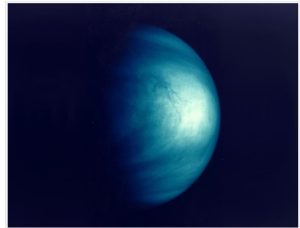
Four years ago a team of scientists found potential evidence of life in the atmosphere of our closest planetary neighbor, Venus, despite the metal-meltingly hot temperature and crushing pressure experienced on the surface; however, this discovery was followed shortly afterward by a dismissal of the claims, after subsequent searches failed to yield the same results. Now, the same scientists that made the out-of-this-world claim in 2020 have gathered more evidence, not only confirming the presence of phosphine, but also discovering that its chemical signature closely follows the day-night cycle of Venus.
Following the initial failure of their 2020 discovery, Dr. Dave Clements, a reader in astrophysics at Imperial College London, returned to observing Venus with the James Clerk Maxwell telescope (JCMT), perched atop Hawaii’s Mauna Kea, to gather more data. In the intervening years, Clements and his team re-discovered the signature for the phosphine, gathering not only more evidence for the chemical’s presence in Venus‘ atmosphere, but also that the waxes and wanes with the diurnal cycle of the heavily-clouded planet.
“Our findings suggest that when the atmosphere is bathed in sunlight the phosphine is destroyed,” Clements explained. “All that we can say is that phosphine is there. We don’t know what’s producing it. It may be chemistry that we don’t understand. Or possibly life.”
Considered to be a potential biosignature in the search for extraterrestrial life, phosphine is a simple organic compound consisting of three hydrogen atoms branching off of a single phosphorus atom. The chemical can be produced through non-biological means, but the process requires a tremendous amount of energy and pressure to force the hydrogen atoms onto the phosphorus.
For instance, phosphine has been found in the atmospheres of Jupiter and Saturn, as these planets have massive, planet-sized storms that can provide the conditions needed to form the compound; however, smaller terrestrial planets can’t produce enough heat and pressure to form phosphine—even the punishing conditions found on Venus are insufficient to account for this process. This leaves biological sources, such as microbes that live in low-oxygen environments, as the only known source, at least here on Earth.
While the conditions found on the surface of Venus consist of a lead-melting 464°C (867°F) and an atmospheric pressure is 91 times greater than that of Earth’s, 50 kilometers (31 miles) the temperature drops to a far more habitable 30°C (86°F) with a more Earth-like pressure; although the sulphuric acid clouds at that altitude still produce a punishing corrosiveness, it’s possible that extremophile organisms may have evolved to thrive in the acidic environment.
Adding to the evidence of possible life on Venus are observations made by Professor Jane Greaves, an astronomer at Cardiff University, who appears to have found the presence of ammonia in the planet’s atmosphere, using West Virginia’s Green Bank radio telescope. Although Greaves’ findings are preliminary, Earth’s ammonia is produced through either biological or industrial processes.
However, Greaves cautions that “even if we confirmed both of these [findings], it is not evidence that we have found these magic microbes and they’re living there today.”
“These are very exciting findings but it must be stressed that the results are only preliminary and more work is needed to learn more about the presence of these two potential biomarkers in Venus’s clouds,” remarked Royal Astronomical Society deputy executive director Dr. Robert Massey. “Nevertheless, it is fascinating to think that these detections could point to either possible signs of life or some unknown chemical processes. It will be interesting to see what further investigations unearth over the coming months and years.”
Subscribers, to watch the subscriber version of the video, first log in then click on Dreamland Subscriber-Only Video Podcast link.